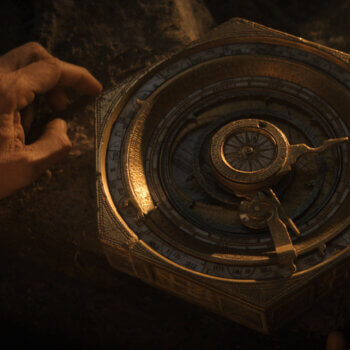In a world in which immediate access to words and information is taken for granted, it is hard to imagine a time when writing began. Archaeological discoveries in ancient Mesopotamia (now mostly modern Iraq) show the initial power and purpose of writing, from administrative and legal functions to poetry and literature.
Mesopotamia was a region comprising many cultures over time speaking different languages. The earliest known writing was invented there around 3400 B.C. in an area called Sumer near the Persian Gulf. The development of a Sumerian script was influenced by local materials: clay for tablets and reeds for styluses (writing tools). At about the same time, or a little later, the Egyptians were inventing their own form of hieroglyphic writing.
Even after Sumerian died out as a spoken language around 2000 B.C., it survived as a scholarly language and script. Other peoples within and near Mesopotamia, from Turkey, Syria, and Egypt to Iran, adopted the later version of this script developed by the Akkadians (the first recognizable Semitic people), who succeeded the Sumerians as rulers of Mesopotamia. In Babylonia itself, the script survived for two more millennia until its demise around 70 C.E.
Early clay models depicting objects were the first Mesopotamian accounting records. These gave way to clay tablets like this one from Uruk with the earliest writing: simplified drawings and number signs. Tablet with Proto-cuneiform Inscription, about 3100 B.C., Proto-urban. Clay, 1 3/4 × 2 13/16 in. Musée du Louvre, Department of Near Eastern Antiquities. Image © RMN-Grand Palais / Art Resource, NY. Photo: Franck Raux
Writing began with pictographs (picture words) drawn into clay with a pointed tool. This early administrative tablet was used to record food rations for people, shown by a person’s head and bowl visible on the lower left side. Pictographs and numbers show amounts of grain allotted to cities and types of workers, including pig herders and groups associated with a religious festival.
Tablets like these helped local leaders organize, manage, and archive information. This tablet reflects bureaucratic accounting, but similar lists were used in the following centuries by individuals to keep track of personal property and business agreements.
From Pictures to Writing in Everyday Life
Writing evolved when someone decided to replace the pointed drawing tool with a triangular reed stylus. The reed could be pressed easily and quickly into clay to make wedges. At first, the wedges were grouped to make pictures, but slowly the groups evolved into more abstract signs and became the sophisticated script we call cuneiform (“wedge-shaped” in Latin). About one thousand signs represented the names of objects and also stood for words, syllables, and sounds (or parts of them).
Cuneiform records provide information about bureaucracy and authority, but they also document many fascinating aspects of daily life. Written texts reveal how individuals and families expressed their wishes, married and had children, did business, and worshipped. People wrote mainly on clay, but also on more expensive materials such as the golden plaque shown above.
This marriage contract is enclosed in a clay envelope, a piece of which has broken off. Tablet in Envelope with a Marriage Contract, 1830–1813 B.C., Amorite. Unfired clay, 5 × 2 5/8 in. Musée du Louvre, Department of Near Eastern Antiquities. Image © RMN-Grand Palais / Art Resource, NY. Photo: Mathieu Rabeau
In this clay marriage contract, which includes an oath to the chief god of Kish where the marriage would have taken place, a father gives his daughter to her new husband. In turn the husband pays a bride-price of silver to three men, perhaps her brothers. The document is enclosed in a clay envelope. Witnesses each rolled personal seals, inscribed cylinders like small rolling pins, across the left side of the envelope to impress a form of signature in relief.
Cylinder Seals as Signatures on Clay
To sign a clay document and sometimes to guarantee that it was officially closed, Mesopotamians used seals, mostly of durable and sometimes expensive materials. Many could be worn or pinned on like jewelry.
This personal stone (chlorite) seal has ends carved to mimic caps in metal. The impression shows the image rolled onto clay. Cylinder Seal of a Royal Baker, about 2150–2000 B.C., Neo-Sumerian. Chlorite, 1 3/8 × 5/8 in. Musée du Louvre, Department of Near Eastern Antiquities. Image © Musée du Louvre, dist. RMN-Grand Palais / Raphaël Chipault / Benjamin Soligny / Art Resource, NY
The cylinder seal above is inscribed with the name of a palace baker. He shows himself standing before an important seated divinity, being introduced by a lesser goddess. In the impression made by rolling the seal, you can see the text and first standing figure start to repeat on the right side.
Seals required special care. Image and text were reversed when pressed into clay, so on the seal a scribe and artist had to create mirror images and inscriptions. In addition, writing on hard materials required totally different techniques from writing directly on clay.
Who Wrote Cuneiform?
Professional writers of cuneiform were called “tablet writers”—scribes. In slow stages of schooling, they learned hundreds of cuneiform signs and memorized texts and templates in different languages. Most were men, but some women could become scribes.
Students’ interests and skills varied, and a proverb noted: “A disgraced scribe becomes a man of magical spells.” This was a pointed reminder that less-committed students might end up making an uncertain living writing common incantations. Working harder could lead to a prosperous life composing legal documents—or even writing correspondence for a royal court. Those who persevered could become scholars with knowledge of mathematics, medicine, religious ritual, divination, laws, and mythology, or even authors of literature.
This clay document is one of a series recording scribal training. Tablet with an Essay on the Education of a Young Scribe, about 2000–1600 B.C., Amorite. Unfired clay, 3 7/8 × 2 1/2 in. Musée du Louvre, Department of Near Eastern Antiquities. Image © Musée du Louvre, dist. RMN-Grand Palais / Raphaël Chipault / Benjamin Soligny / Art Resource, NY
This tablet is one of more than twenty similar tablets (nicknamed “Schooldays”) that present the life of a young student in a scribal school. The days were long, filled with copying and memorizing. Older scribes oversaw these efforts, while the school was led by a headmaster. The document records a usual day:
“I read my tablet, ate my lunch,
prepared my [new] tablet, wrote it, finished it; then
my model tablets were brought to me;
and in the afternoon, my exercise tablets were brought to me.”
(Translation by S. N. Kramer, The Sumerians: Their History, Culture, and Character, 1963)
On this day the boy feels successful, but on the next, his teachers repeatedly beat him for infractions such as tardiness, talking, and poor handwriting. In the end, the boy’s father invites the headmaster to dinner and gives him gifts and money. Appeased (and bought off, although such payments may have been expected), the headmaster declares to the boy: “You have carried out well the school’s activities. You are a man of learning!”
Many people may have learned the basics of reading and writing, including royals. The first known author was Enheduanna, the daughter of Sargon, king of Akkad, the first king to conquer all of Mesopotamia. She was a priestess who composed religious poetry. Later, the Neo-Assyrian king Ashurbanipal praised his own literacy and scholarship. He is sometimes shown in royal art with a writing stylus stuck in his belt.
Although cuneiform endured for over three thousand years, as simpler alphabets became common the script was eventually used only for scholarly documents, and it faded away completely in the late-first century A.D. Within a few centuries, all understanding of the once-dominant writing was lost for about 1,800 years.
How Cuneiform Was Deciphered
This Babylonian stone record found near Baghdad was the first notable cuneiform document seen in Europe. Land Grant Stele (“Caillou Michaux”), 1100–1083 B.C., Mesopotamian. Serpentine, 15 3/4 × 8 11/16 in. Bibliothéque nationale de France. Image © BnF
In the 1700s, scholars began to take note of cuneiform on surviving clay fragments and stone monuments, but they did not understand what was written. In 1786, when a French traveler brought this dramatic black kudurru, a small stone monument, to Paris, inventive translations of the text were proposed, such as “The army of heaven gives us vinegar to drink solely to provide us remedies able to bring us healing.”
When its true meaning was eventually deciphered, the stone was found to record a gift of land from a father to his daughter upon her marriage. The careful father stipulates that her new father-in-law will not claim the land as his. The horned, scaly being at the top of the stone is Nabu, a divine patron of scribes who oversees the proper execution of the contract.
The text was written in Akkadian cuneiform, the written language of the conquerors of the Sumerians, which was undeciphered until the mid-1800s.
An Assyrian scribe holding a stylus and clay tablet records objects taken from a defeated city. Relief Decoration from Tiglath-Pilesar III’s Central Palace at Nimrud, about 728 B.C. British Museum ME118882; photo by Greta Van Buylaere
By then, some scholars were convinced that they could read Akkadian texts. Others thought they were just guessing. Finally, in 1857 the Royal Asiatic Society issued a challenge to four experts: Provide independent translations of a newly found, unpublished Akkadian inscription for judgment by a jury. Each academic received a copy of the inscription and returned a translation within a set time.
The text was an account of a king’s military successes. One dramatic excerpt declared: “Their carcasses covered the valleys and the tops of the mountains. I cut off their heads. The battlements of their cities I made heaps of, like mounds of earth!” The scholars were vindicated when a jury found their translations similar and declared Akkadian cuneiform deciphered! Read the account here.
In the 1800s and 1900s, archaeological excavations revealed thousands of cuneiform documents, and the variations of the script across languages and time were slowly deciphered.
While we can read cuneiform documents today, the majority—many hundreds of thousands—still survive unread, and the few hundred cuneiform experts worldwide face an impossible task. Fortunately, machine learning offers potential assistance. Scholars at many institutions are compiling databases and training machines to read and fill in gaps in these ancient texts.
Find out more about Mesopotamia, and the exhibition Mesopotamia: Civilization Begins.



































